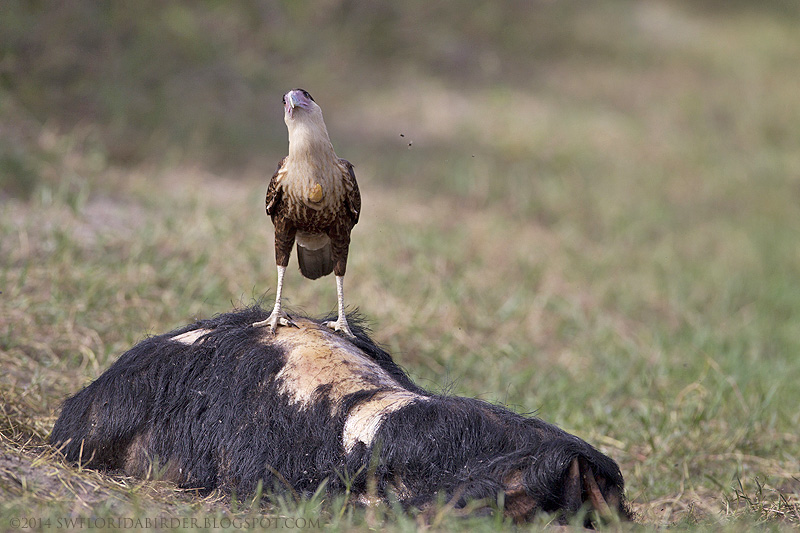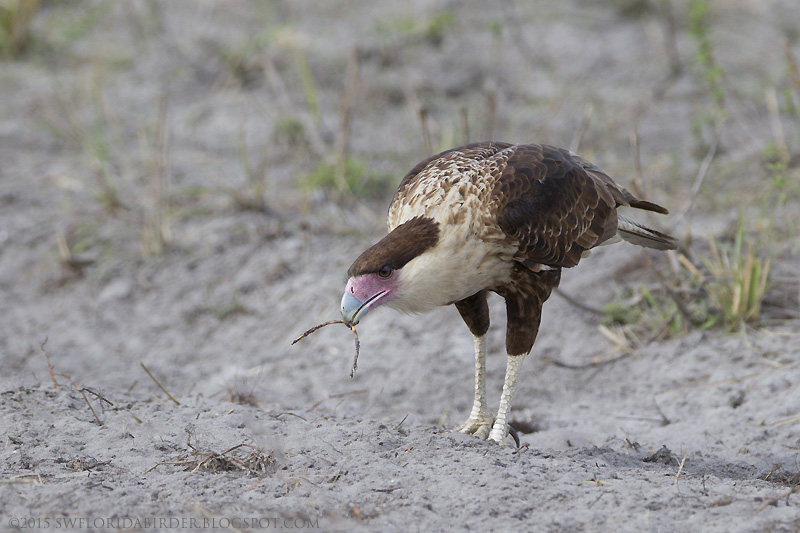Church Road in Felda, Florida, is a wildlife amusement park with images presented here from 3 and 6 December.
The Crested Caracara above (image 1) was photographed at Church Road in January 2015.
There should definitely be a concern for vehicular traffic on this road which travels at a high speed. Weekend days are best for minimal disturbance. If you are inclined to stop on the road, which you will, make sure to use care at all times.
The Crested Caracara above (image 2) was photographed at Church Road in January 2015.
The Crested Caracara above (image 3) was photographed at Church Road in January 2015.
The Crested Caracara above (image 4) was photographed at Church Road in January 2015.
The Crested Caracara above (image 5) was photographed at Church Road in January 2015.
The Black Vulture above (image 6) was photographed at Church Road in January 2015.
This two-part article highlights the prolific Northern Crested Caracara which can be seen at Church Road ideally near sunrise or sunset. Many dozens of other species of bird and mammal shouldn't be overlooked including prolific butterflies and dragonflies.
The Black Vulture above (image 7) was photographed at Church Road in January 2015.
The Turkey Vulture above (image 8) was photographed at Church Road in January 2015.
The Western Kingbird above (image 9) was photographed at Church Road in January 2015.
The Great Southern White Butterfly above (image 10) was photographed at Church Road in January 2015.
The Crested Caracara above (image 11) was photographed at Church Road in January 2015.
I mention the caracara as Northern Crested Caracara for the first time here due to my research on the Florida subspecies which was learned to be a remnant of the last ice age that occurred about 10,500 BC. Crested Caracara could not escape their plight through migration since they don't engage in that behavior.
The Wood Stork above (image 12) was photographed at Church Road in January 2015.
The Wood Stork above (image 13) was photographed at Church Road in January 2015.
The Wood Stork above (image 14) was photographed at Church Road in January 2015.
The Wood Stork above (image 15) was photographed at Church Road in January 2015.
The Crested Caracara above (image 16) was photographed at Church Road in January 2015.
Caracara with a pink face indicate juveniles. It was noted by J. Lyons' Wildlife Rehabilitation (1984) that the face of Crested Caracara will be orange-red in color when the bird is at rest, though when under stress will change to a pumpkin color to yellow.
The Crested Caracara above (image 17) was photographed at Church Road in January 2015.
The Crested Caracara above (image 18) was photographed at Church Road in January 2015.
The Crested Caracara above (image 19) was photographed at Church Road in January 2015.
The Crested Caracara above (image 20) was photographed at Church Road in January 2015.
The Crested Caracara above (image 21) was photographed at Church Road in January 2015.
Caracara during breeding season will sport a bump on its breast in my observations at Church Road. I have not seen this characteristic reported anywhere in my research. It was determined that this occurs on the female while observing a copulation event.
The Crested Caracara above (image 22) was photographed at Church Road in January 2015.
The Crested Caracara above (image 23) was photographed at Church Road in January 2015.
The Crested Caracara above (image 24) was photographed at Church Road in January 2015.
The Crested Caracara above (image 25) was photographed at Church Road in January 2015.
The Crested Caracara above (image 26) was photographed at Church Road in January 2015.
This unusual anatomical characteristic of the caracara is missing from birding resources including the oiseaux-birds website. Their notation of the caracara's face changing color is otherwise interesting, though I have never seen this happen in real time.
The Crested Caracara above (image 27) was photographed at Church Road in January 2015.
The Crested Caracara above (image 28) was photographed at Church Road in January 2015.
The Crested Caracara above (image 29) was photographed at Church Road in January 2015.
The Crested Caracara above (image 30) was photographed at Church Road in January 2015.
The Crested Caracara above (image 31) was photographed at Church Road in January 2015.
The Northern Crested Caracara is noted to be a protected bird, though of "Least Concern." Caracara is a food source in southern parts of its range in a report from 2010. In this 2014/2015 season, there have been very good numbers of caracara observed.
The Crested Caracara above (image 32) was photographed at Church Road in January 2015.
The copulating Crested Caracara above (image 33) were photographed at Church Road in January 2015.
The Boat-tailed Grackle above (image 34) was photographed at Church Road in January 2015.
The Black Vulture above (image 35) was photographed at Church Road in January 2015.
The Black Vulture above (image 36) was photographed at Church Road in January 2015.
Copulation of the caracara observed during my 6 December visit to Church Road is considered early for the nesting season. This is an especially great time of year to make a trip to Church Road in Felda off of highway 82, just west of highway 29.
The Black Vulture above (image 37) was photographed at Church Road in January 2015.
Please also see Church Road Crested Caracara Overload: Part I






































Loved # 23....my favorite! Thanks Bob!
ReplyDeleteAdele
Thank you, Adele. The sunrise light was unusually accommodating that morning.
DeleteEcho what Adele said there....those images from 23 to 32 are a bit special Bob
ReplyDeleteThank you, Brian. The caracara are approaching peak mating behavior this month. It would be special to observe a nest.
DeleteBob -- wonderful photography and documentation. The bump on the breast is probably an engorged crop; a feature shared by other carrion eaters like vultures and some storks (eg., Adjutant).
ReplyDeleteThank you, Hemant. I appreciate the clarification of the engorged crop.
Delete